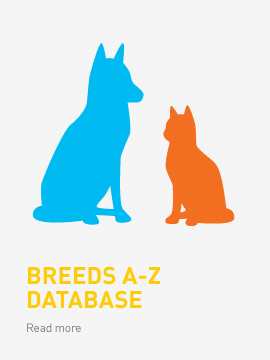Air Travel
With the emergence of many ‘budget airlines’ throughout Europe, more people are able to travel and sometimes with their pets. Pet travel policies vary widely between airlines, so be sure to check with the airline before you book a ticket. Cats and small dogs often can travel within the cabin under your seat while larger dogs must travel in the cargo hold. If you need to travel with your Service or Guide Dog, let the airline know at booking, as these animals are allowed to travel in the cabin.
During certain times of the year your pet may not be allowed to travel in the cargo hold. The cargo hold is temperature and pressure controlled while in flight, but it is not while the aircraft is on the ground. This may mean that your pet is exposed to extreme temperatures. Some airlines, such as United, have a special pet service which holds the animals in a climate-controlled vehicle by the aircraft and loads them right before the doors are closed. This type of service prevents exposure to extreme temperatures once your pet is checked in, helping to prevent travel-related illness. However, this service does not help when there are gate delays after landing. The most common health problems encountered while flying include hyperthermia, hypothermia and dehydration. With proper preparation, these complications are rare.
Some airlines prohibit transport of certain breeds for the sake of the animal’s health. Brachycephalic breeds (those with “smushed faces” or very short noses, such as Persian cats, Pugs and Boston Terriers) are more likely to suffer from travel complications due to their unique anatomy. These dogs are more likely to suffer from hyperthermia or airway compromise. They also cannot cool themselves adequately when exposed to high temperatures or even when they are very excited. It is best for these breeds to travel on the ground or in the aircraft cabin.
Certain breeds may be banned by airlines or must travel in a special, extra-secure type of metal crate. These include fighting breeds and bulldogs such as Pit Bulls, Mastiffs and Staffordshire Bull Terriers. This is not necessarily because the airline views these breeds as dangerous to people; it is because these dogs have especially strong jaws. There have been cases in the past where Pit Bull-type dogs have chewed their way through a plastic crate and damaged the interior of the aircraft cargo hold while in flight!
To minimize stress while flying:
- Pick a direct flight to your destination. Lay-overs increase the amount of time your pet is stressed and can contribute to dehydration.
- Travel during the coolest time of the day if possible.
- Get your pet used to the travel crate in advance. Most crate-trained dogs are very bonded with their ‘den’ and this may make travel less stressful for them.
- If your dog is prone to chewing on fabric, don’t place a blanket in the crate. While soft padding may seem comfortable, some dogs decide to ingest it when they are bored – potentially leading to an intestinal obstruction.
- The day before travel, freeze water in a container for your pet. Before setting off for the airport, attach this container to the interior of the crate or the door. The ice will slowly melt and help prevent spillage. Many dogs enjoy licking ice!
- For other information, please see our Quick Travel Tips pages for Dogs and Cats.
Travel by Train
Train travel can still be stressful for your pet. The new sights, sounds and even the movement of the train itself can be unnerving. If it is possible, take your pet on a few short train trips before the big day. This can help him or her get used to the process.
Most trains throughout Europe are “pet friendly” but contact the rail company for pet policy details before booking.
While travelling by train, remember:
- Keep your pet secure. Cats and small dogs should travel within a carrier at all times. Larger dogs should be kept on a short leash and on a secure collar or harness.
- A water source should be accessible to your pet at all times. Carry a water bottle with you, as some trains may not offer opportunities to purchase water while aboard or the water in the bathrooms is non-potable.
- Travel during the coolest part of the day. In some countries, trains are not climate controlled. If there is a delay, the cabins can become quite hot – exposing your pet to additional stress.
- The movement of the train can sometimes cause motion sickness. For helpful tips about prevention of motion sickness in pets, click here.
- For more tips on what you should take with you on the train, see our Quick Travel Tips pages for Dogs and Cats and Check List.
Ferry or Ship Travel
Travelling by water is a fun experience but may involve some unique preparation. Some ferry operators will allow your pet to accompany you on the decks, but others require the pet to remain in a crate below decks. Most pet policies will not allow the pet to stay in your car during the crossing. If you are travelling on an overnight ferry, be sure that your pet is allowed to stay in the cabin with you while you sleep.
Even if the seas are not high that day, even gentle rocking of the ship can cause motion sickness in dogs and people. For more information about how to prevent motion sickness, please click here.
If you take a ferry on your journey, remember:
- Travel during the coolest part of the day. Sometimes you must wait quite a while in the car hold before disembarking.
- Keep your pet hydrated. If your pet must stay crated and in a holding area below decks, ask about this process before you go. Some areas of the ship are ‘off-limits’ while at sea and this will prevent you from checking on your pet. If your pet must be alone and crated for the crossing, attach a frozen bowl of water to the inside of the crate before setting out. This will allow your pet to have water for a longer period of time during travel.
- Keep your pet secure. Cats and small dogs should travel within a carrier at all times. Larger dogs should be kept on a short leash fixed to a secure collar or harness.
- For more tips on what you should take with you on the ferry, see our Quick Travel Tips pages for Dogs and Cats and Check List.
Travel by car
Car travel is very popular and may offer you the most amount of flexibility. Car travel can be as stressful as other forms of transport, so it is important to prepare your pet as best you can. It is very easy for pets to become overheated in a car, especially if your automobile does not have air conditioning. It is safest for pets to travel in a secure container while in a car. This includes carriers or crates for dogs and cats. If using a crate for your large dog is not possible, be sure to secure him or her with a “doggie seat belt” in the back seat of the car. The front seat is not safe for pets even with a seat belt, as air bag deployment can severely injure or kill pets. If your pet must ride in the front seat, be sure to disengage the passenger air bag.
On long journeys you should:
- Always have plenty of water on hand. Offer your pet water every couple of hours.
- Feed your pet at least two hours before travel. This will help prevent motion sickness. If you must start your journey before mealtimes, plan a light meal while you are on your way.
- Regular toilet breaks are necessary for all members of the family. If you have a cat, carry a small plastic litter tray with you. A small amount of cat litter can be carried in a zip-top bag until it is time for a toilet break.
- The litter tray can be easily put in the floorboard of your car. During a travel break, be sure the windows and doors are securely closed and let your cat out of the carrier. He or she may be thankful for a toilet break and a chance to ‘stretch legs’! The harness will help you to put your cat back into the carrier after the stop.
- Don’t be discouraged if your cat does not use the litter tray. It is best for his or her health to allow for the opportunity to toilet. Long periods of “holding it” may predispose pets to bladder infections.
- For more tips on what you should take with you in the car, see our Quick Travel Tips pages for Dogs and Cats and Check List.






